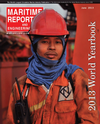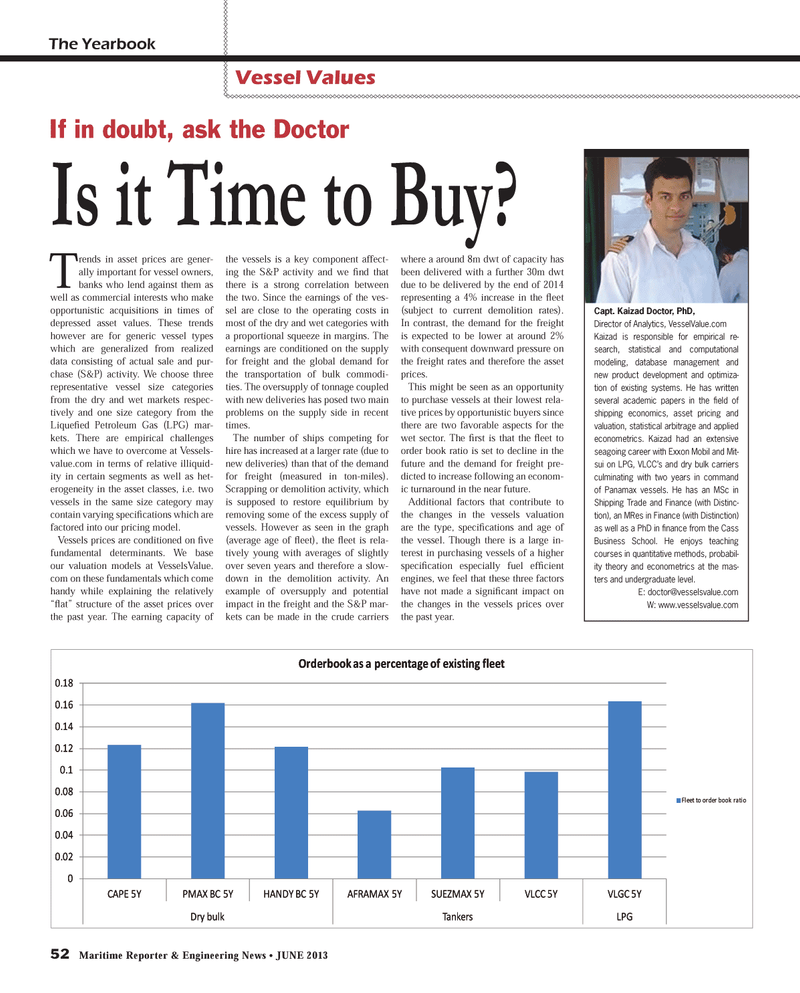
Page 52: of Maritime Reporter Magazine (June 2013)
Annual World Yearbook
Read this page in Pdf, Flash or Html5 edition of June 2013 Maritime Reporter Magazine
52 Maritime Reporter & Engineering News ? JUNE 2013 Trends in asset prices are gener- ally important for vessel owners, banks who lend against them as well as commercial interests who make opportunistic acquisitions in times of depressed asset values. These trends however are for generic vessel types which are generalized from realized data consisting of actual sale and pur- chase (S&P) activity. We choose three representative vessel size categories from the dry and wet markets respec-tively and one size category from the LiqueÞ ed Petroleum Gas (LPG) mar- kets. There are empirical challenges which we have to overcome at Vessels- value.com in terms of relative illiquid-ity in certain segments as well as het-erogeneity in the asset classes, i.e. two vessels in the same size category may contain varying speciÞ cations which are factored into our pricing model. Vessels prices are conditioned on Þ ve fundamental determinants. We base our valuation models at VesselsValue. com on these fundamentals which come handy while explaining the relatively ?ß at? structure of the asset prices over the past year. The earning capacity of the vessels is a key component affect- ing the S&P activity and we Þ nd that there is a strong correlation between the two. Since the earnings of the ves-sel are close to the operating costs in most of the dry and wet categories with a proportional squeeze in margins. The earnings are conditioned on the supply for freight and the global demand for the transportation of bulk commodi-ties. The oversupply of tonnage coupled with new deliveries has posed two main problems on the supply side in recent times. The number of ships competing for hire has increased at a larger rate (due to new deliveries) than that of the demand for freight (measured in ton-miles). Scrapping or demolition activity, which is supposed to restore equilibrium by removing some of the excess supply of vessels. However as seen in the graph (average age of ß eet), the ß eet is rela- tively young with averages of slightly over seven years and therefore a slow-down in the demolition activity. An example of oversupply and potential impact in the freight and the S&P mar- kets can be made in the crude carriers where a around 8m dwt of capacity has been delivered with a further 30m dwt due to be delivered by the end of 2014 representing a 4% increase in the ß eet (subject to current demolition rates). In contrast, the demand for the freight is expected to be lower at around 2% with consequent downward pressure on the freight rates and therefore the asset prices. This might be seen as an opportunity to purchase vessels at their lowest rela-tive prices by opportunistic buyers since there are two favorable aspects for the wet sector. The Þ rst is that the ß eet to order book ratio is set to decline in the future and the demand for freight pre-dicted to increase following an econom-ic turnaround in the near future. Additional factors that contribute to the changes in the vessels valuation are the type, speciÞ cations and age of the vessel. Though there is a large in- terest in purchasing vessels of a higher speciÞ cation especially fuel ef Þ cient engines, we feel that these three factors have not made a signiÞ cant impact on the changes in the vessels prices over the past year. The YearbookVessel ValuesIs it Time to Buy?If in doubt, ask the Doctor00.02 0.04 0.06 0.08 0.1 0.12 0.14 0.16 0.18 CAPE 5Y PMAX BC 5Y HANDY BC 5Y AFRAMAX 5Y SUEZMAX 5Y VLCC 5Y VLGC 5Y Dry bulk Tankers LPGOrderbook as a percentage of existing fleet Fleet to order book ratio Capt. Kaizad Doctor, PhD, Director of Analytics, VesselValue.com Kaizad is responsible for empirical re- search, statistical and computational modeling, database management and new product development and optimiza- tion of existing systems. He has written several academic papers in the Þ eld of shipping economics, asset pricing and valuation, statistical arbitrage and applied econometrics. Kaizad had an extensive seagoing career with Exxon Mobil and Mit- sui on LPG, VLCCÕs and dry bulk carriers culminating with two years in command of Panamax vessels. He has an MSc in Shipping Trade and Finance (with Distinc- tion), an MRes in Finance (with Distinction) as well as a PhD in Þ nance from the Cass Business School. He enjoys teaching courses in quantitative methods, probabil- ity theory and econometrics at the mas-ters and undergraduate level. E: [email protected]: www.vesselsvalue.com MR #6 (50-57).indd 52MR #6 (50-57).indd 525/31/2013 9:55:32 AM5/31/2013 9:55:32 AM

 51
51

 53
53
